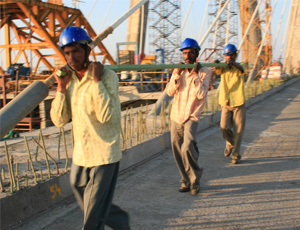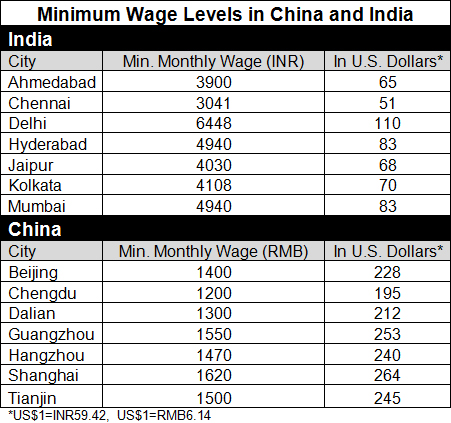Op-ed Commentary: Chris Devonshire-Ellis, Dezan Shira & Associates
 Jul. 18 – Comparing labor costs is always a difficult art, not least because different countries have different ways and mechanisms of measuring these. India, for example, imposes different minimum wage levels dependent upon specific work sectors, whereas China levies a minimum wage across the board irrespective of employment type. However, as the population demographics are now shifting to a younger workforce in India from China, such comparisons, while not exact, provide some clues about the nature of costs associated within the labor pools of each.
Jul. 18 – Comparing labor costs is always a difficult art, not least because different countries have different ways and mechanisms of measuring these. India, for example, imposes different minimum wage levels dependent upon specific work sectors, whereas China levies a minimum wage across the board irrespective of employment type. However, as the population demographics are now shifting to a younger workforce in India from China, such comparisons, while not exact, provide some clues about the nature of costs associated within the labor pools of each.
In this example, we have researched seven cities in both China and India, to try and provide a general geographic spread in both countries. The minimum wage levels in each country are set by the respective state and provincial governments. The results are as follows:

It should be noted that in China, a mandatory welfare payment is added to the minimum wage as paid by the employer and this typically adds an average 30 percent to 50 percent on top of the minimum wage identified above. India does not levy a uniform welfare payment upon salaries, and this can either be discounted completely or is a typical maximum of 10 percent of wages.
The figures adequately demonstrate that Chinese minimum wages are two or three times the level of their Indian counterparts, and even higher when welfare payments are added on top. This bears out our previous findings that China now has one of the highest employment costs in emerging Asia and that the population demographics now favor India.
In India, the development of a large, yet young labor force with an average age of 23 is showing itself in lower minimum salary levels. In China, however, where the average age of a worker is now 37, the higher minimum wage and more expensive welfare to cater for that age is now having a significant effect in demonstrating the labor cost gap.
The message for labor-intensive industries is clear – India is now a key market for establishing operations.
Chris Devonshire-Ellis is the founding partner of Dezan Shira & Associates. Established in 1992, the firm provides foreign direct investment advice into Asia on behalf of companies around the world, including SMEs from emerging markets within Africa, the Middle East, Latin America and emerging Asia. Please email asia@dezshira.com for assistance or visit the firm’s website at www.dezshira.com for more information.
You can stay up to date with the latest business and investment trends across Asia by subscribing to Asia Briefing’s complimentary update service featuring news, commentary, guides, and multimedia resources.
Related Reading
China-India Purchasing Power and Expenditure Comparison
China’s Demographics Point to India as the Next Global Manufacturing Hub
Why India is Winning the Entrepreneurial Battle with China
Is Doing Business in India More Difficult than in China?
Asia’s High Net Worth Individuals Concentrated in China & India


